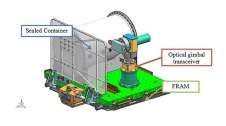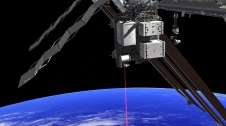Space station OPALS points to ramped up returns for research

It is a good thing that nobody ever told the International Space Station that it is considered rude to point. Scientists plan to ignore this much touted rule of manners when using the orbiting research platform to host a technology investigation to "point" back to Earth to improve data return communication capabilities from space.
Current spacecraft send data to Earth using radio frequency, but the Optical Payload for Lasercomm Science (OPALS) will test the use of laser optics to transfer information to the ground. The switch from radio frequency to a laser beam—which can be hundreds to thousands of times narrower in comparison to radio waves—could improve communication data rates by a factor of 10 to 100. This advanced approach stands to increase the amount of data future missions can send using the same power resources, optimizing research return.
"OPALS represents a tangible stepping stone for laser communications, and the International Space Station is a great platform for an experiment like this," said Michael Kokorowski, OPALS project manager at NASA's Jet Propulsion Laboratory (JPL) in Pasadena, Calif. "Future operational laser communication systems will have the ability to transmit more data from spacecraft down to the ground than they currently do, mitigating a significant bottleneck for scientific investigations and commercial ventures."
During tests, a laser beacon will transmit between OPALS and a telescope at the Optical Communications Telescope Laboratory, a JPL ground station in Wrightwood, Calif., while the space station is flying overhead. OPALS's on-board camera system tracks the line-of-sight between the instrument and telescope while a two-axis gimbal and closed-loop system maintain a lock on the uplink beacon.
Each demonstration lasts about two minutes, during which OPALS will downlink a pre-encoded formatted video using the modulated laser beam. The precision of this pointing is the real challenge for optical communications, also termed "lasercomm."

"It's like aiming a laser pointer continuously for two minutes at a dot the diameter of a human hair from 30 feet away while you're walking," explained OPALS systems engineer Bogdan Oaida of JPL.
The instrument's system consists of three main components. The first is a sealed container that houses the laser and electronics. This container connects via cables to the second mechanism, a two-axis gimbal-mounted optical transceiver that includes a camera receiver and collimated laser transmitter for downlink. Finally, there is the Flight Releasable Attachment Mechanism (FRAM) that the sealed container and gimbal transceiver sit on. The FRAM also provides the electrical and mechanical connection to the space station and launch vehicle.
"Our particular payload is actually trying to do something that is relatively modest by optical communications standards," said Oaida during an interview. "That is because the focus is not so much to show that we can do high data rates, but rather to show that we can do optical communications. The sort of rates we will be getting are about 10 to 50 times faster than what you would get at home in your typical cable Internet."
Although OPALS is a demonstration, future applications of this technology promise to increase the efficiency of transmitting science data from the space station, while also having applications for deep space and satellite communications. Such optimizations factor into the ability of people on the ground to receive higher definition video feeds from near-Earth and deep-space assets, improving the interaction and experience with the related missions. Testing in orbit also helps train engineers on the ground and can lead to improved optical communication instrument design.
OPALS recently transferred from JPL to NASA's Kennedy Space Center in Florida. There, it is undergoing final interface testing before launch to the space station aboard the SpaceX Dragon commercial resupply capsule, scheduled for late 2013.
The instrument will be installed on the Express Logistics Carrier (ELC) on the exterior of the station where it will operate for 90 days, performing test demonstrations of the optical communications technology. Researchers will analyze the technical data to determine how well the hardware performs.
With the space station operating at full capacity, the amount of research taking place and generating data continues to grow. Likewise, advances in technology, such as high definition video feeds, require greater communication capabilities. An optimization such as OPALS may mean greater return for the investigations, providing scientists that much more data at their fingertips as they seek answers for studies looking at various science disciplines.
The goal is to use information from OPALS testing to improve future designs for optical communications systems. In the case of this instrument it would be rude not to point to the potential it provides for improvements in communications between spacecraft for future exploration missions and commercial endeavors.
Provided by NASA




















